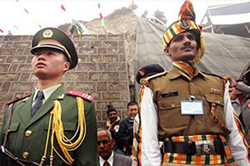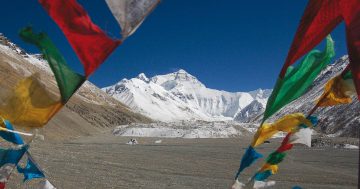Brahma Chellaney* says the issues of Tibet and the Dalai Lama succession will not go away amid increasing fraught tensions between China and India.
 Is China’s insecurity over the restive Tibetan Plateau driving President Xi Jinping’s belligerent policy toward India?
Is China’s insecurity over the restive Tibetan Plateau driving President Xi Jinping’s belligerent policy toward India?
The extended stand-off between the two nations in their border region has raised the risks of further localised battles or another full-scale war.
Xi recently underscored his regime’s anxieties by ordering Communist Party, Government and military leaders to turn Tibet into an “impregnable fortress” against separatism and “solidify border defences” to ensure frontier security with India.
He also called for the Sinicising of Tibetan Buddhism to help accelerate the Tibetan minority’s assimilation into the dominant Han culture.
Several issues are fuelling Xi’s concerns over Tibet.
These are controlling who succeeds the 85-year-old Dalai Lama; continued Tibetan resistance to Chinese rule; and China’s growing suspicions about India, which hosts a Tibetan Government-in-exile and welcomes fleeing Tibetans.
Xi has sought to root out all signs of unrest in Tibet, the world’s largest and highest plateau. Tibet’s capital, Lhasa, is more than 3,500 kilometres Beijing, but only 1,356 kilometres from New Delhi.
The Tibetan frontier with India was largely peaceful for centuries before China occupied Tibet in 1951.
With its conquest of the ‘Roof of the World’, China enlarged its landmass by more than a third and fundamentally altered Asia’s geostrategic landscape.
After imposing itself as India’s neighbour, China refused to accept the Indo-Tibetan boundary’s customary alignment, which led to a bloody border war in 1962.
That war, however, didn’t settle the territorial disputes, with China subsequently laying claim to more Indian territories beyond those it seized in 1962.
As China’s encroachments into India’s northern-most highlands since April show, Beijing is claiming these areas on the basis of alleged Tibetan ecclesial or tutelary links.
Tibet, despite disappearing as a buffer, remains at the heart of the China-India divide, fuelling land disputes, diplomatic tensions, and — given that most of Asia’s great river systems originate on the Tibetan Plateau — feuds over the Chinese re-engineering of cross-border river flows.
Under Xi, China has introduced measures to snuff out Tibetan culture and cut Tibetans off from ancient traditions, including herding and farming.
Recent reports have shed light on a coerced labour program to forcibly assimilate Tibetans, including through military drill-style skills training.
China has also forced the last remaining Tibetan-language school to teach in Chinese.
India, however, has been funding Tibetan-language schools for its large Tibetan refugee community.
The Dalai Lama, who says the Chinese Communist Party has transformed Tibet into a “hell on earth”, has spearheaded the effort to maintain Tibetan culture from his home in India.
For Xi, capturing the 442-year-old institution of the Dalai Lama is a pivotal final step toward securing China’s hold over Tibet.
India, however, continues to stand in the way of Xi’s plan to install a pawn to succeed the current 14th Dalai Lama.
Underscoring the sharpening geopolitics, the United States Congress is close to passing the new Tibetan Policy and Support Act, which mandates financial and travel sanctions against Chinese officials who interfere in the Dalai Lama’s succession.
India, acting on the Dalai Lama’s instructions, could tacitly help Tibetan exiles find, appoint and protect his successor.
The Dalai Lama has said his “reincarnation will appear in a free country”, which could mean in India’s Tibetan-Buddhist Himalayan regions.
This explains why China has intensified its claim to Tawang, the birthplace of the sixth Dalai Lama.
Despite catching India’s military off-guard in Ladakh, located more than 1,500 kilometres from Tawang, Xi seems to have greatly underestimated India’s capacity to recoup from initial setbacks and fight back.
About a month ago, Indian special forces stunned China by occupying vacant mountain heights overlooking key Chinese positions on the southern side of Ladakh’s Pangong Lake.
Even more humiliating for Beijing is the fact that the Indian operation was spearheaded by a special force made up entirely of Tibetan exiles.
India rubbed salt in the wound by holding a well-attended military funeral for a Tibetan soldier killed in that operation, with his coffin draped in both the Indian and Tibetan national flags.
The funeral’s key message was that, just as China uses Pakistan to contain India, New Delhi can use Tibet as leverage against Beijing.
India’s daring seizure of the heights has drawn international attention to its secretive, all-Tibetan Special Frontier Force, established after the 1962 war.
The itch to fight the occupiers of their homeland has drawn Tibetan recruits to this force.
Xi, China’s most powerful leader since Mao, is working to complete Mao’s expansionist vision, from the East and South China Seas to the Himalayan region.
However, his aggression against India may not be progressing as planned.
His real achievement may be sowing the seeds of the world’s next big conflict and ensuring the rise of a more antagonistic India.
This means Tibet’s shadow will only grow longer over China-India relations in the coming years.
*Brahma Chellaney is a geo-strategist and the author of nine books on security issues. He is Professor of Strategic Studies at the Centre for Policy Research in New Delhi.
This article first appeared on the Nikkei Asia website.




